Analysis of Design Features: The Earthquake-Resistant Philippine Arena
VerifiedAdded on 2022/09/14
|14
|2876
|13
Report
AI Summary
This report provides a detailed analysis of the design features of the Philippine Arena, the world's largest indoor arena. It examines the arena's structural components, including the lower bowl, upper bowl, and roofing systems, and how they contribute to its earthquake resistance. The report explores the use of reinforced concrete, steel, and innovative design techniques such as diaphragms and braced frames to mitigate seismic forces. It also discusses the importance of the arena's location in Metro Manila and the soil's liquefaction resistance. Comparisons with pre-existing designs highlight the arena's advanced technology and structural strength. The analysis covers the design of the lower bowl, upper bowl, and roofing systems, emphasizing the innovative methods used to distribute loads and enhance the arena's stability against ground shaking. The report concludes by emphasizing the critical importance of the design features in creating a sustainable and resilient structure.
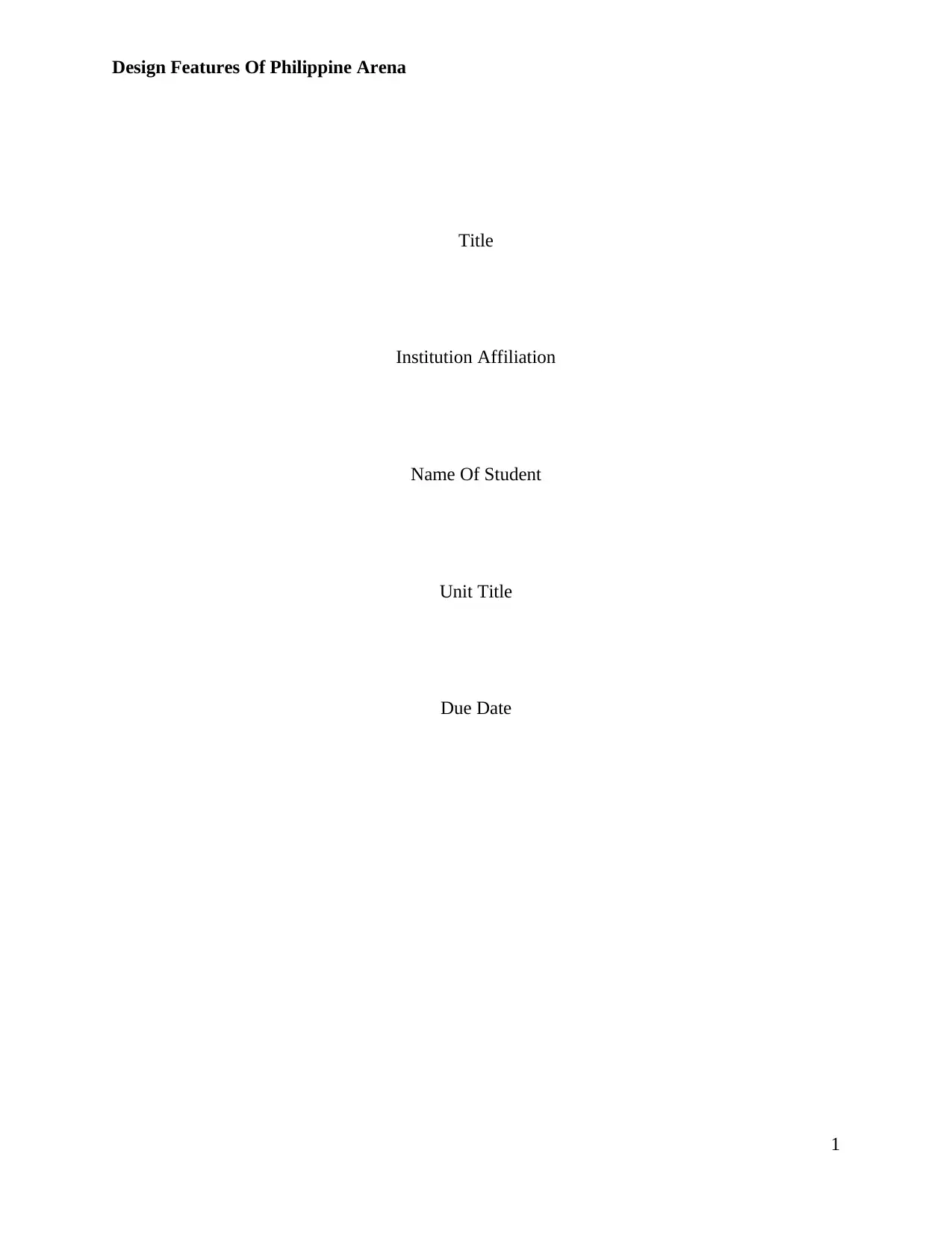
Design Features Of Philippine Arena
Title
Institution Affiliation
Name Of Student
Unit Title
Due Date
1
Title
Institution Affiliation
Name Of Student
Unit Title
Due Date
1
Paraphrase This Document
Need a fresh take? Get an instant paraphrase of this document with our AI Paraphraser
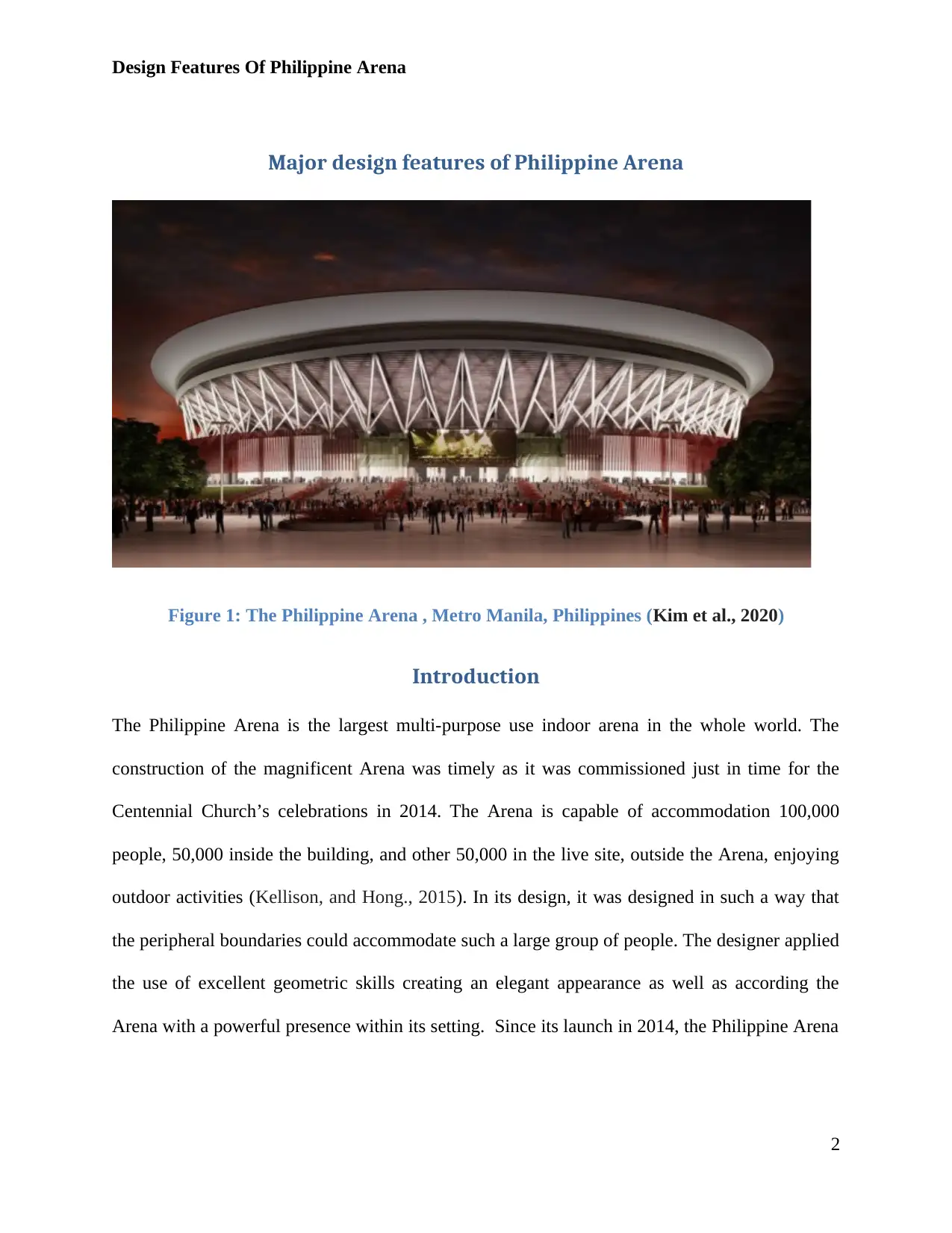
Design Features Of Philippine Arena
Major design features of Philippine Arena
Figure 1: The Philippine Arena , Metro Manila, Philippines (Kim et al., 2020)
Introduction
The Philippine Arena is the largest multi-purpose use indoor arena in the whole world. The
construction of the magnificent Arena was timely as it was commissioned just in time for the
Centennial Church’s celebrations in 2014. The Arena is capable of accommodation 100,000
people, 50,000 inside the building, and other 50,000 in the live site, outside the Arena, enjoying
outdoor activities (Kellison, and Hong., 2015). In its design, it was designed in such a way that
the peripheral boundaries could accommodate such a large group of people. The designer applied
the use of excellent geometric skills creating an elegant appearance as well as according the
Arena with a powerful presence within its setting. Since its launch in 2014, the Philippine Arena
2
Major design features of Philippine Arena
Figure 1: The Philippine Arena , Metro Manila, Philippines (Kim et al., 2020)
Introduction
The Philippine Arena is the largest multi-purpose use indoor arena in the whole world. The
construction of the magnificent Arena was timely as it was commissioned just in time for the
Centennial Church’s celebrations in 2014. The Arena is capable of accommodation 100,000
people, 50,000 inside the building, and other 50,000 in the live site, outside the Arena, enjoying
outdoor activities (Kellison, and Hong., 2015). In its design, it was designed in such a way that
the peripheral boundaries could accommodate such a large group of people. The designer applied
the use of excellent geometric skills creating an elegant appearance as well as according the
Arena with a powerful presence within its setting. Since its launch in 2014, the Philippine Arena
2
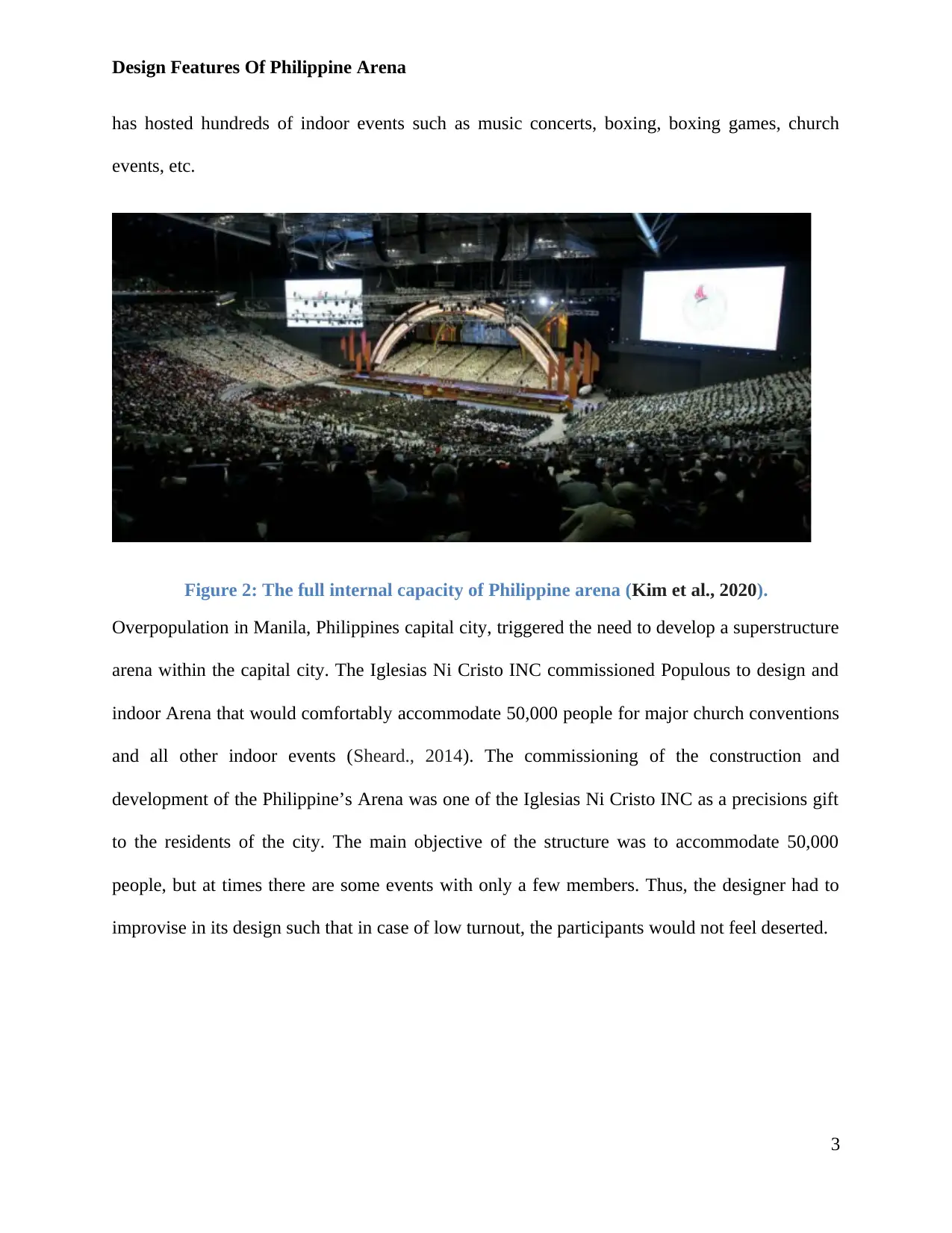
Design Features Of Philippine Arena
has hosted hundreds of indoor events such as music concerts, boxing, boxing games, church
events, etc.
Figure 2: The full internal capacity of Philippine arena (Kim et al., 2020).
Overpopulation in Manila, Philippines capital city, triggered the need to develop a superstructure
arena within the capital city. The Iglesias Ni Cristo INC commissioned Populous to design and
indoor Arena that would comfortably accommodate 50,000 people for major church conventions
and all other indoor events (Sheard., 2014). The commissioning of the construction and
development of the Philippine’s Arena was one of the Iglesias Ni Cristo INC as a precisions gift
to the residents of the city. The main objective of the structure was to accommodate 50,000
people, but at times there are some events with only a few members. Thus, the designer had to
improvise in its design such that in case of low turnout, the participants would not feel deserted.
3
has hosted hundreds of indoor events such as music concerts, boxing, boxing games, church
events, etc.
Figure 2: The full internal capacity of Philippine arena (Kim et al., 2020).
Overpopulation in Manila, Philippines capital city, triggered the need to develop a superstructure
arena within the capital city. The Iglesias Ni Cristo INC commissioned Populous to design and
indoor Arena that would comfortably accommodate 50,000 people for major church conventions
and all other indoor events (Sheard., 2014). The commissioning of the construction and
development of the Philippine’s Arena was one of the Iglesias Ni Cristo INC as a precisions gift
to the residents of the city. The main objective of the structure was to accommodate 50,000
people, but at times there are some events with only a few members. Thus, the designer had to
improvise in its design such that in case of low turnout, the participants would not feel deserted.
3
⊘ This is a preview!⊘
Do you want full access?
Subscribe today to unlock all pages.

Trusted by 1+ million students worldwide
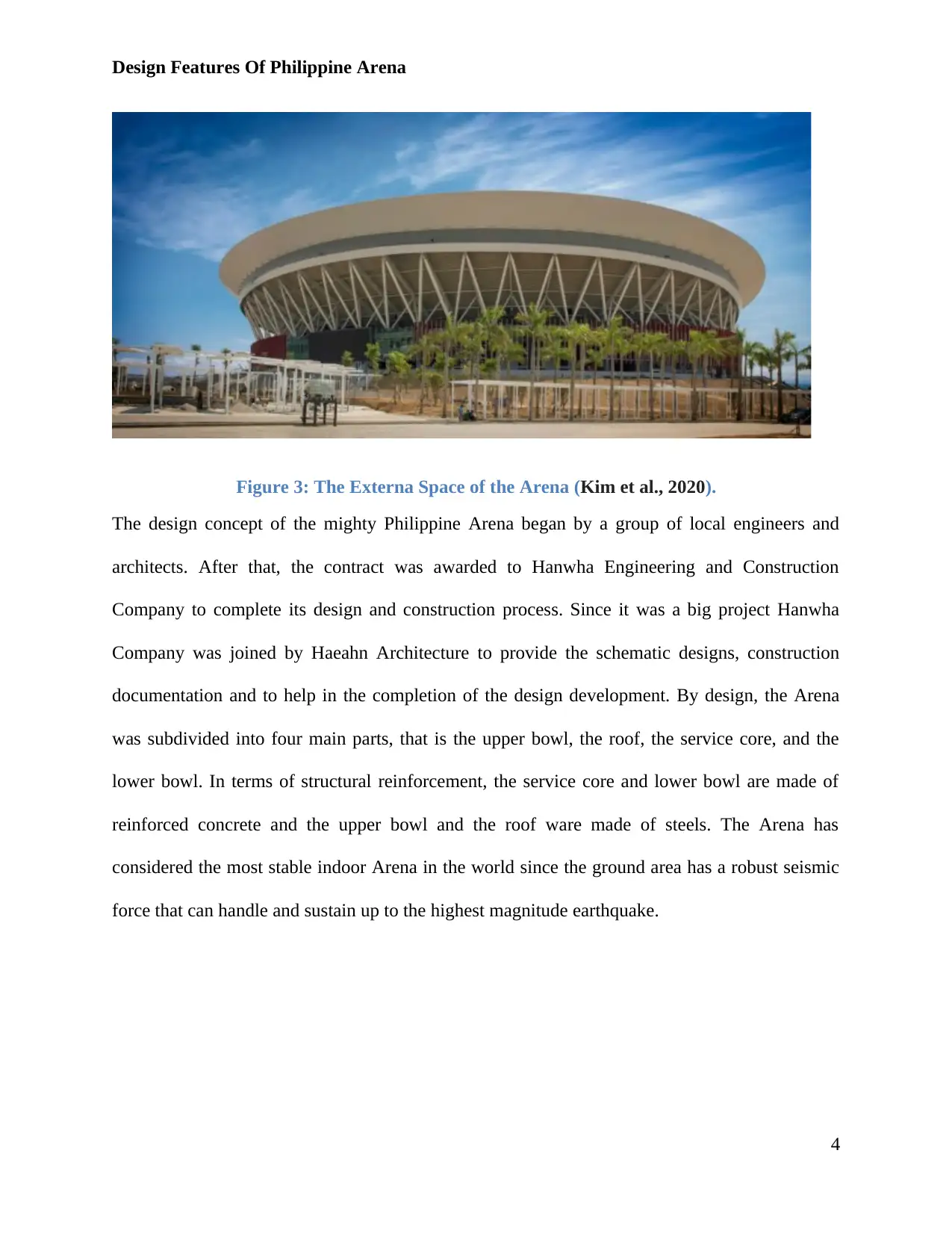
Design Features Of Philippine Arena
Figure 3: The Externa Space of the Arena (Kim et al., 2020).
The design concept of the mighty Philippine Arena began by a group of local engineers and
architects. After that, the contract was awarded to Hanwha Engineering and Construction
Company to complete its design and construction process. Since it was a big project Hanwha
Company was joined by Haeahn Architecture to provide the schematic designs, construction
documentation and to help in the completion of the design development. By design, the Arena
was subdivided into four main parts, that is the upper bowl, the roof, the service core, and the
lower bowl. In terms of structural reinforcement, the service core and lower bowl are made of
reinforced concrete and the upper bowl and the roof ware made of steels. The Arena has
considered the most stable indoor Arena in the world since the ground area has a robust seismic
force that can handle and sustain up to the highest magnitude earthquake.
4
Figure 3: The Externa Space of the Arena (Kim et al., 2020).
The design concept of the mighty Philippine Arena began by a group of local engineers and
architects. After that, the contract was awarded to Hanwha Engineering and Construction
Company to complete its design and construction process. Since it was a big project Hanwha
Company was joined by Haeahn Architecture to provide the schematic designs, construction
documentation and to help in the completion of the design development. By design, the Arena
was subdivided into four main parts, that is the upper bowl, the roof, the service core, and the
lower bowl. In terms of structural reinforcement, the service core and lower bowl are made of
reinforced concrete and the upper bowl and the roof ware made of steels. The Arena has
considered the most stable indoor Arena in the world since the ground area has a robust seismic
force that can handle and sustain up to the highest magnitude earthquake.
4
Paraphrase This Document
Need a fresh take? Get an instant paraphrase of this document with our AI Paraphraser
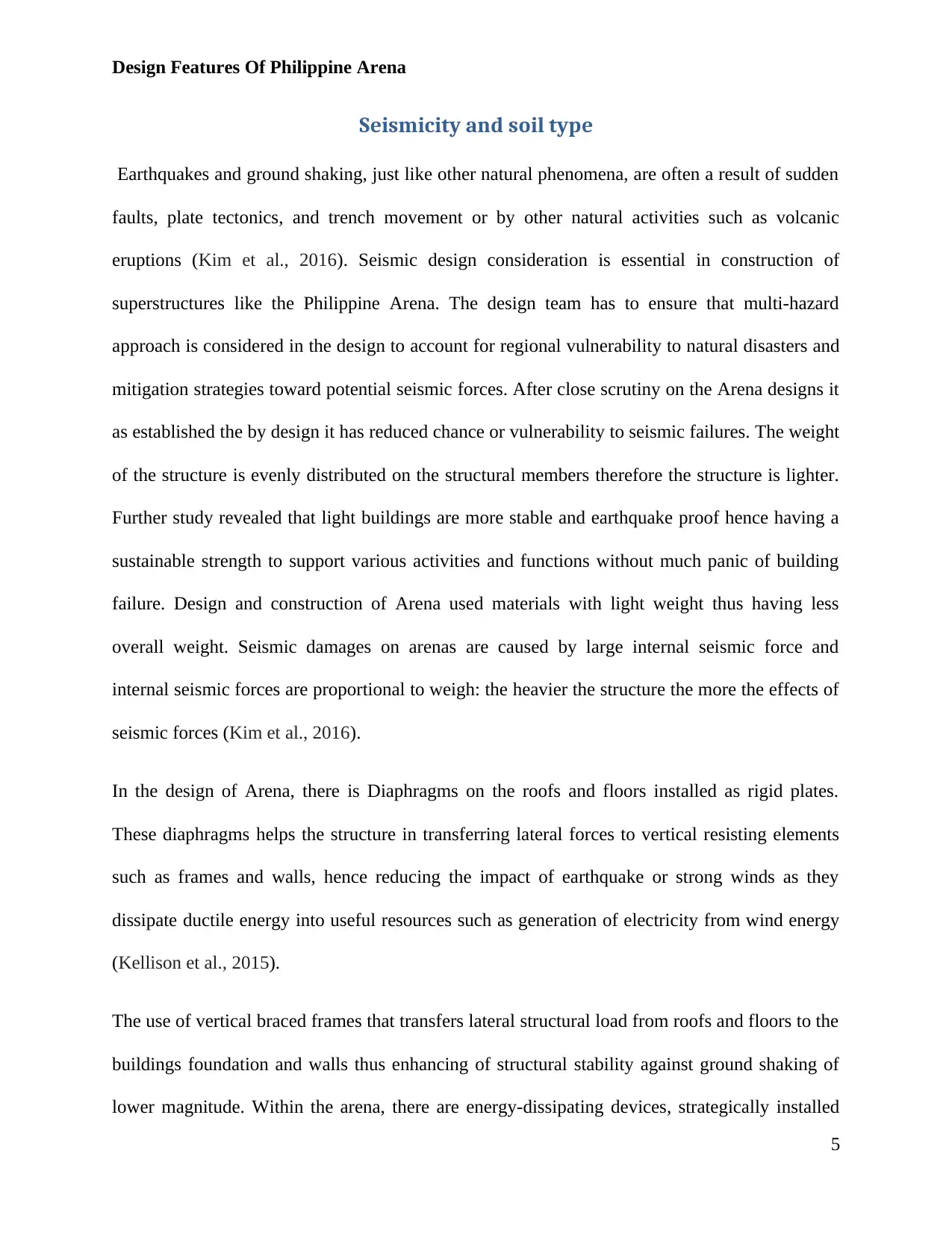
Design Features Of Philippine Arena
Seismicity and soil type
Earthquakes and ground shaking, just like other natural phenomena, are often a result of sudden
faults, plate tectonics, and trench movement or by other natural activities such as volcanic
eruptions (Kim et al., 2016). Seismic design consideration is essential in construction of
superstructures like the Philippine Arena. The design team has to ensure that multi-hazard
approach is considered in the design to account for regional vulnerability to natural disasters and
mitigation strategies toward potential seismic forces. After close scrutiny on the Arena designs it
as established the by design it has reduced chance or vulnerability to seismic failures. The weight
of the structure is evenly distributed on the structural members therefore the structure is lighter.
Further study revealed that light buildings are more stable and earthquake proof hence having a
sustainable strength to support various activities and functions without much panic of building
failure. Design and construction of Arena used materials with light weight thus having less
overall weight. Seismic damages on arenas are caused by large internal seismic force and
internal seismic forces are proportional to weigh: the heavier the structure the more the effects of
seismic forces (Kim et al., 2016).
In the design of Arena, there is Diaphragms on the roofs and floors installed as rigid plates.
These diaphragms helps the structure in transferring lateral forces to vertical resisting elements
such as frames and walls, hence reducing the impact of earthquake or strong winds as they
dissipate ductile energy into useful resources such as generation of electricity from wind energy
(Kellison et al., 2015).
The use of vertical braced frames that transfers lateral structural load from roofs and floors to the
buildings foundation and walls thus enhancing of structural stability against ground shaking of
lower magnitude. Within the arena, there are energy-dissipating devices, strategically installed
5
Seismicity and soil type
Earthquakes and ground shaking, just like other natural phenomena, are often a result of sudden
faults, plate tectonics, and trench movement or by other natural activities such as volcanic
eruptions (Kim et al., 2016). Seismic design consideration is essential in construction of
superstructures like the Philippine Arena. The design team has to ensure that multi-hazard
approach is considered in the design to account for regional vulnerability to natural disasters and
mitigation strategies toward potential seismic forces. After close scrutiny on the Arena designs it
as established the by design it has reduced chance or vulnerability to seismic failures. The weight
of the structure is evenly distributed on the structural members therefore the structure is lighter.
Further study revealed that light buildings are more stable and earthquake proof hence having a
sustainable strength to support various activities and functions without much panic of building
failure. Design and construction of Arena used materials with light weight thus having less
overall weight. Seismic damages on arenas are caused by large internal seismic force and
internal seismic forces are proportional to weigh: the heavier the structure the more the effects of
seismic forces (Kim et al., 2016).
In the design of Arena, there is Diaphragms on the roofs and floors installed as rigid plates.
These diaphragms helps the structure in transferring lateral forces to vertical resisting elements
such as frames and walls, hence reducing the impact of earthquake or strong winds as they
dissipate ductile energy into useful resources such as generation of electricity from wind energy
(Kellison et al., 2015).
The use of vertical braced frames that transfers lateral structural load from roofs and floors to the
buildings foundation and walls thus enhancing of structural stability against ground shaking of
lower magnitude. Within the arena, there are energy-dissipating devices, strategically installed
5
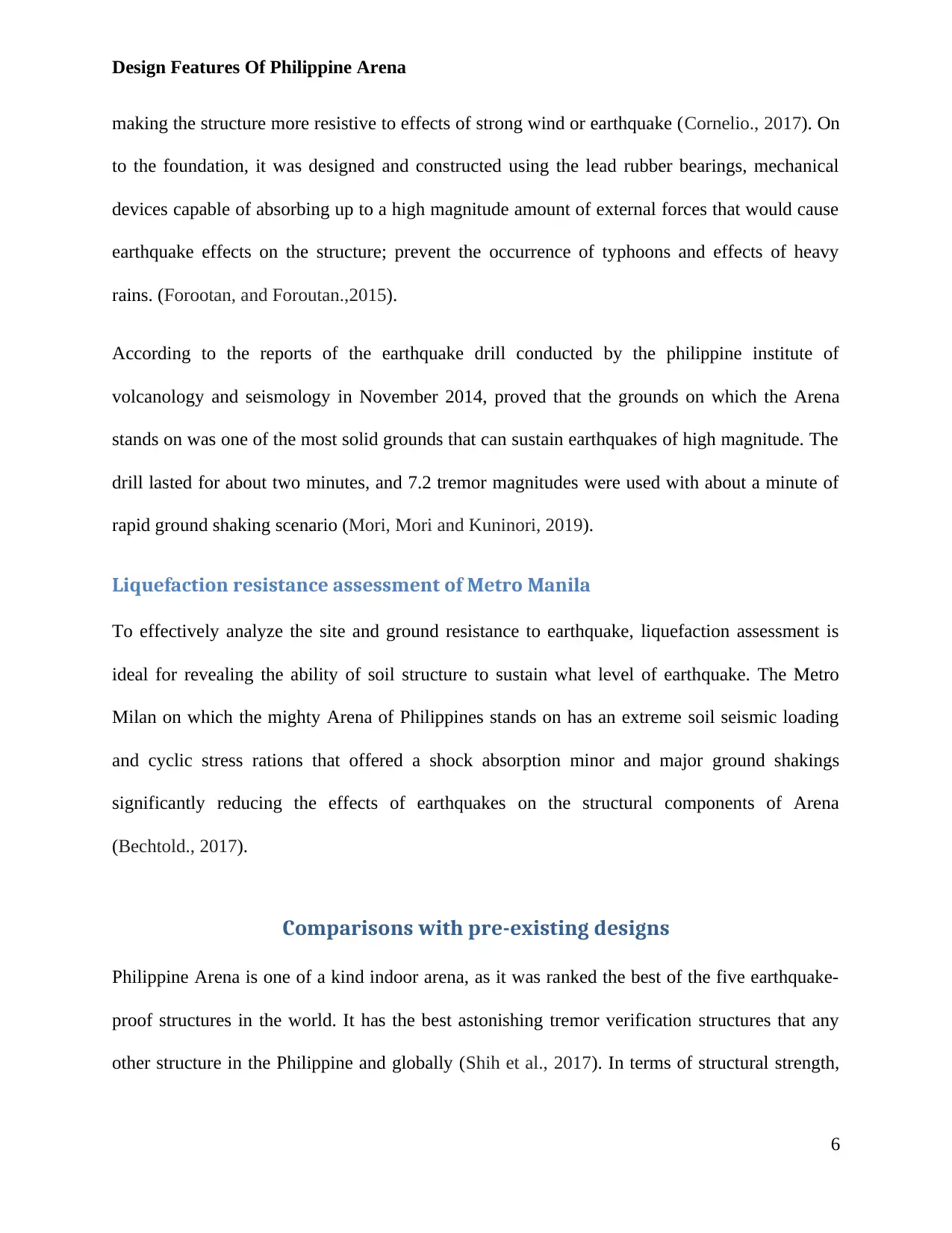
Design Features Of Philippine Arena
making the structure more resistive to effects of strong wind or earthquake (Cornelio., 2017). On
to the foundation, it was designed and constructed using the lead rubber bearings, mechanical
devices capable of absorbing up to a high magnitude amount of external forces that would cause
earthquake effects on the structure; prevent the occurrence of typhoons and effects of heavy
rains. (Forootan, and Foroutan.,2015).
According to the reports of the earthquake drill conducted by the philippine institute of
volcanology and seismology in November 2014, proved that the grounds on which the Arena
stands on was one of the most solid grounds that can sustain earthquakes of high magnitude. The
drill lasted for about two minutes, and 7.2 tremor magnitudes were used with about a minute of
rapid ground shaking scenario (Mori, Mori and Kuninori, 2019).
Liquefaction resistance assessment of Metro Manila
To effectively analyze the site and ground resistance to earthquake, liquefaction assessment is
ideal for revealing the ability of soil structure to sustain what level of earthquake. The Metro
Milan on which the mighty Arena of Philippines stands on has an extreme soil seismic loading
and cyclic stress rations that offered a shock absorption minor and major ground shakings
significantly reducing the effects of earthquakes on the structural components of Arena
(Bechtold., 2017).
Comparisons with pre-existing designs
Philippine Arena is one of a kind indoor arena, as it was ranked the best of the five earthquake-
proof structures in the world. It has the best astonishing tremor verification structures that any
other structure in the Philippine and globally (Shih et al., 2017). In terms of structural strength,
6
making the structure more resistive to effects of strong wind or earthquake (Cornelio., 2017). On
to the foundation, it was designed and constructed using the lead rubber bearings, mechanical
devices capable of absorbing up to a high magnitude amount of external forces that would cause
earthquake effects on the structure; prevent the occurrence of typhoons and effects of heavy
rains. (Forootan, and Foroutan.,2015).
According to the reports of the earthquake drill conducted by the philippine institute of
volcanology and seismology in November 2014, proved that the grounds on which the Arena
stands on was one of the most solid grounds that can sustain earthquakes of high magnitude. The
drill lasted for about two minutes, and 7.2 tremor magnitudes were used with about a minute of
rapid ground shaking scenario (Mori, Mori and Kuninori, 2019).
Liquefaction resistance assessment of Metro Manila
To effectively analyze the site and ground resistance to earthquake, liquefaction assessment is
ideal for revealing the ability of soil structure to sustain what level of earthquake. The Metro
Milan on which the mighty Arena of Philippines stands on has an extreme soil seismic loading
and cyclic stress rations that offered a shock absorption minor and major ground shakings
significantly reducing the effects of earthquakes on the structural components of Arena
(Bechtold., 2017).
Comparisons with pre-existing designs
Philippine Arena is one of a kind indoor arena, as it was ranked the best of the five earthquake-
proof structures in the world. It has the best astonishing tremor verification structures that any
other structure in the Philippine and globally (Shih et al., 2017). In terms of structural strength,
6
⊘ This is a preview!⊘
Do you want full access?
Subscribe today to unlock all pages.

Trusted by 1+ million students worldwide
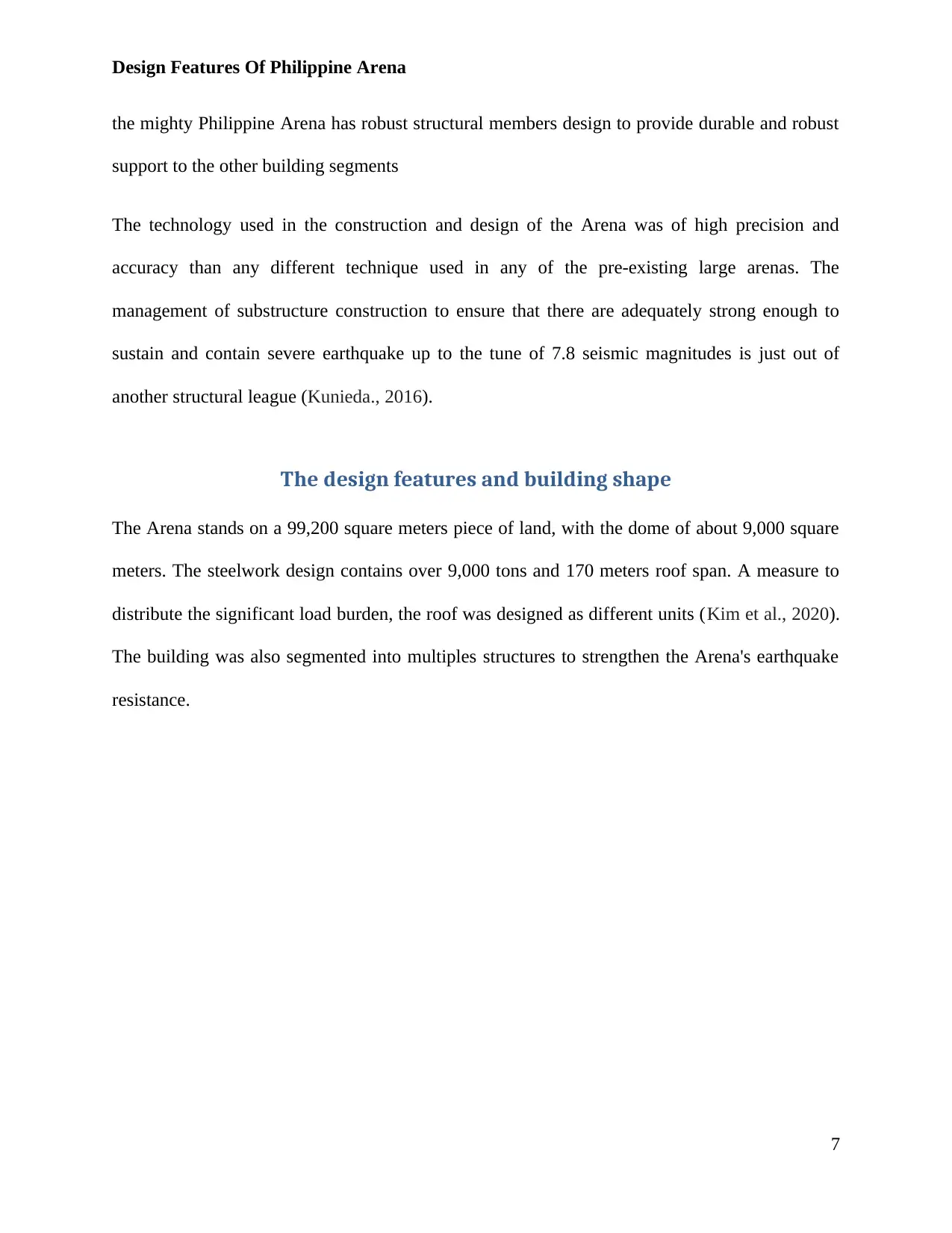
Design Features Of Philippine Arena
the mighty Philippine Arena has robust structural members design to provide durable and robust
support to the other building segments
The technology used in the construction and design of the Arena was of high precision and
accuracy than any different technique used in any of the pre-existing large arenas. The
management of substructure construction to ensure that there are adequately strong enough to
sustain and contain severe earthquake up to the tune of 7.8 seismic magnitudes is just out of
another structural league (Kunieda., 2016).
The design features and building shape
The Arena stands on a 99,200 square meters piece of land, with the dome of about 9,000 square
meters. The steelwork design contains over 9,000 tons and 170 meters roof span. A measure to
distribute the significant load burden, the roof was designed as different units (Kim et al., 2020).
The building was also segmented into multiples structures to strengthen the Arena's earthquake
resistance.
7
the mighty Philippine Arena has robust structural members design to provide durable and robust
support to the other building segments
The technology used in the construction and design of the Arena was of high precision and
accuracy than any different technique used in any of the pre-existing large arenas. The
management of substructure construction to ensure that there are adequately strong enough to
sustain and contain severe earthquake up to the tune of 7.8 seismic magnitudes is just out of
another structural league (Kunieda., 2016).
The design features and building shape
The Arena stands on a 99,200 square meters piece of land, with the dome of about 9,000 square
meters. The steelwork design contains over 9,000 tons and 170 meters roof span. A measure to
distribute the significant load burden, the roof was designed as different units (Kim et al., 2020).
The building was also segmented into multiples structures to strengthen the Arena's earthquake
resistance.
7
Paraphrase This Document
Need a fresh take? Get an instant paraphrase of this document with our AI Paraphraser
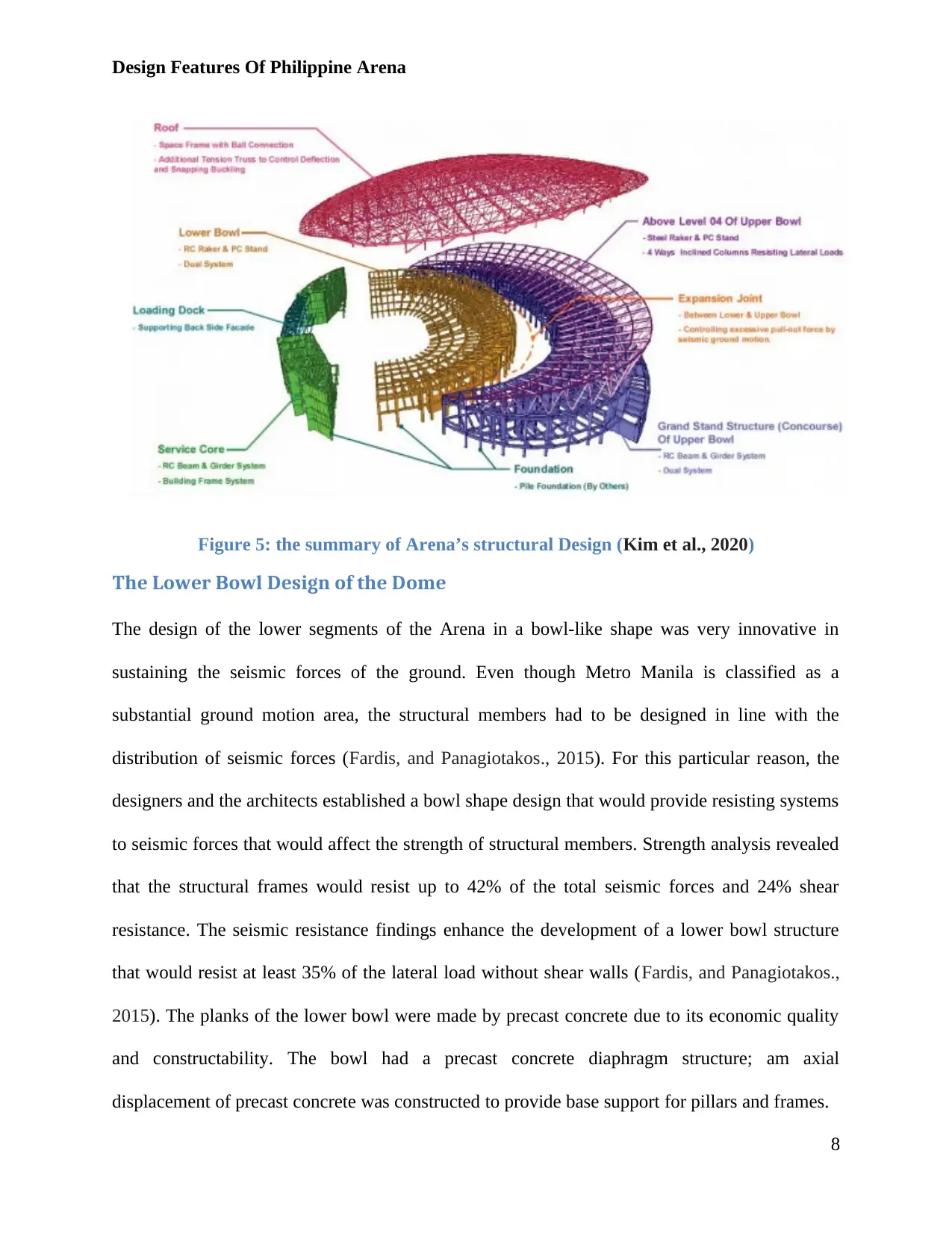
Design Features Of Philippine Arena
Figure 5: the summary of Arena’s structural Design (Kim et al., 2020)
The Lower Bowl Design of the Dome
The design of the lower segments of the Arena in a bowl-like shape was very innovative in
sustaining the seismic forces of the ground. Even though Metro Manila is classified as a
substantial ground motion area, the structural members had to be designed in line with the
distribution of seismic forces (Fardis, and Panagiotakos., 2015). For this particular reason, the
designers and the architects established a bowl shape design that would provide resisting systems
to seismic forces that would affect the strength of structural members. Strength analysis revealed
that the structural frames would resist up to 42% of the total seismic forces and 24% shear
resistance. The seismic resistance findings enhance the development of a lower bowl structure
that would resist at least 35% of the lateral load without shear walls (Fardis, and Panagiotakos.,
2015). The planks of the lower bowl were made by precast concrete due to its economic quality
and constructability. The bowl had a precast concrete diaphragm structure; am axial
displacement of precast concrete was constructed to provide base support for pillars and frames.
8
Figure 5: the summary of Arena’s structural Design (Kim et al., 2020)
The Lower Bowl Design of the Dome
The design of the lower segments of the Arena in a bowl-like shape was very innovative in
sustaining the seismic forces of the ground. Even though Metro Manila is classified as a
substantial ground motion area, the structural members had to be designed in line with the
distribution of seismic forces (Fardis, and Panagiotakos., 2015). For this particular reason, the
designers and the architects established a bowl shape design that would provide resisting systems
to seismic forces that would affect the strength of structural members. Strength analysis revealed
that the structural frames would resist up to 42% of the total seismic forces and 24% shear
resistance. The seismic resistance findings enhance the development of a lower bowl structure
that would resist at least 35% of the lateral load without shear walls (Fardis, and Panagiotakos.,
2015). The planks of the lower bowl were made by precast concrete due to its economic quality
and constructability. The bowl had a precast concrete diaphragm structure; am axial
displacement of precast concrete was constructed to provide base support for pillars and frames.
8
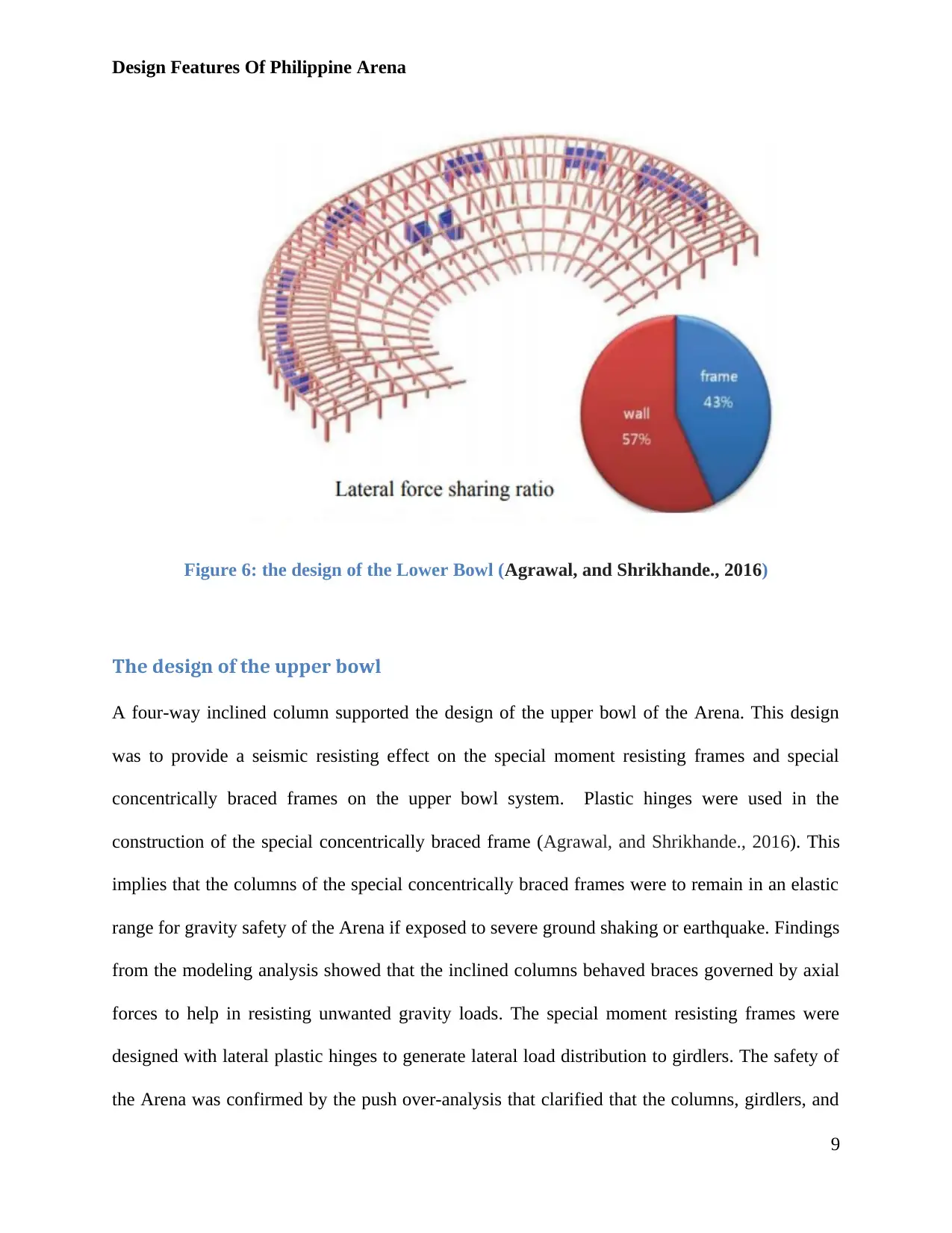
Design Features Of Philippine Arena
Figure 6: the design of the Lower Bowl (Agrawal, and Shrikhande., 2016)
The design of the upper bowl
A four-way inclined column supported the design of the upper bowl of the Arena. This design
was to provide a seismic resisting effect on the special moment resisting frames and special
concentrically braced frames on the upper bowl system. Plastic hinges were used in the
construction of the special concentrically braced frame (Agrawal, and Shrikhande., 2016). This
implies that the columns of the special concentrically braced frames were to remain in an elastic
range for gravity safety of the Arena if exposed to severe ground shaking or earthquake. Findings
from the modeling analysis showed that the inclined columns behaved braces governed by axial
forces to help in resisting unwanted gravity loads. The special moment resisting frames were
designed with lateral plastic hinges to generate lateral load distribution to girdlers. The safety of
the Arena was confirmed by the push over-analysis that clarified that the columns, girdlers, and
9
Figure 6: the design of the Lower Bowl (Agrawal, and Shrikhande., 2016)
The design of the upper bowl
A four-way inclined column supported the design of the upper bowl of the Arena. This design
was to provide a seismic resisting effect on the special moment resisting frames and special
concentrically braced frames on the upper bowl system. Plastic hinges were used in the
construction of the special concentrically braced frame (Agrawal, and Shrikhande., 2016). This
implies that the columns of the special concentrically braced frames were to remain in an elastic
range for gravity safety of the Arena if exposed to severe ground shaking or earthquake. Findings
from the modeling analysis showed that the inclined columns behaved braces governed by axial
forces to help in resisting unwanted gravity loads. The special moment resisting frames were
designed with lateral plastic hinges to generate lateral load distribution to girdlers. The safety of
the Arena was confirmed by the push over-analysis that clarified that the columns, girdlers, and
9
⊘ This is a preview!⊘
Do you want full access?
Subscribe today to unlock all pages.

Trusted by 1+ million students worldwide
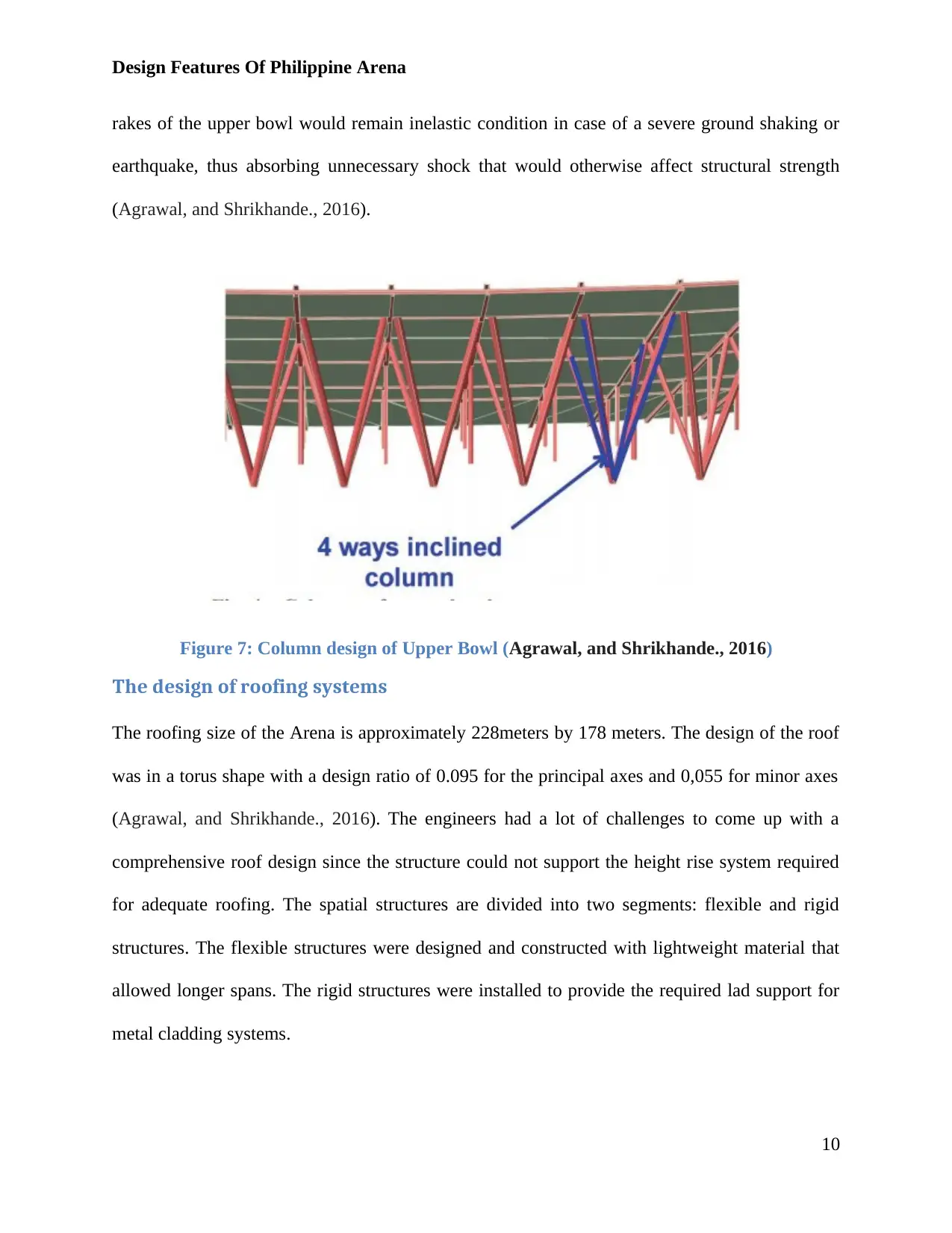
Design Features Of Philippine Arena
rakes of the upper bowl would remain inelastic condition in case of a severe ground shaking or
earthquake, thus absorbing unnecessary shock that would otherwise affect structural strength
(Agrawal, and Shrikhande., 2016).
Figure 7: Column design of Upper Bowl (Agrawal, and Shrikhande., 2016)
The design of roofing systems
The roofing size of the Arena is approximately 228meters by 178 meters. The design of the roof
was in a torus shape with a design ratio of 0.095 for the principal axes and 0,055 for minor axes
(Agrawal, and Shrikhande., 2016). The engineers had a lot of challenges to come up with a
comprehensive roof design since the structure could not support the height rise system required
for adequate roofing. The spatial structures are divided into two segments: flexible and rigid
structures. The flexible structures were designed and constructed with lightweight material that
allowed longer spans. The rigid structures were installed to provide the required lad support for
metal cladding systems.
10
rakes of the upper bowl would remain inelastic condition in case of a severe ground shaking or
earthquake, thus absorbing unnecessary shock that would otherwise affect structural strength
(Agrawal, and Shrikhande., 2016).
Figure 7: Column design of Upper Bowl (Agrawal, and Shrikhande., 2016)
The design of roofing systems
The roofing size of the Arena is approximately 228meters by 178 meters. The design of the roof
was in a torus shape with a design ratio of 0.095 for the principal axes and 0,055 for minor axes
(Agrawal, and Shrikhande., 2016). The engineers had a lot of challenges to come up with a
comprehensive roof design since the structure could not support the height rise system required
for adequate roofing. The spatial structures are divided into two segments: flexible and rigid
structures. The flexible structures were designed and constructed with lightweight material that
allowed longer spans. The rigid structures were installed to provide the required lad support for
metal cladding systems.
10
Paraphrase This Document
Need a fresh take? Get an instant paraphrase of this document with our AI Paraphraser
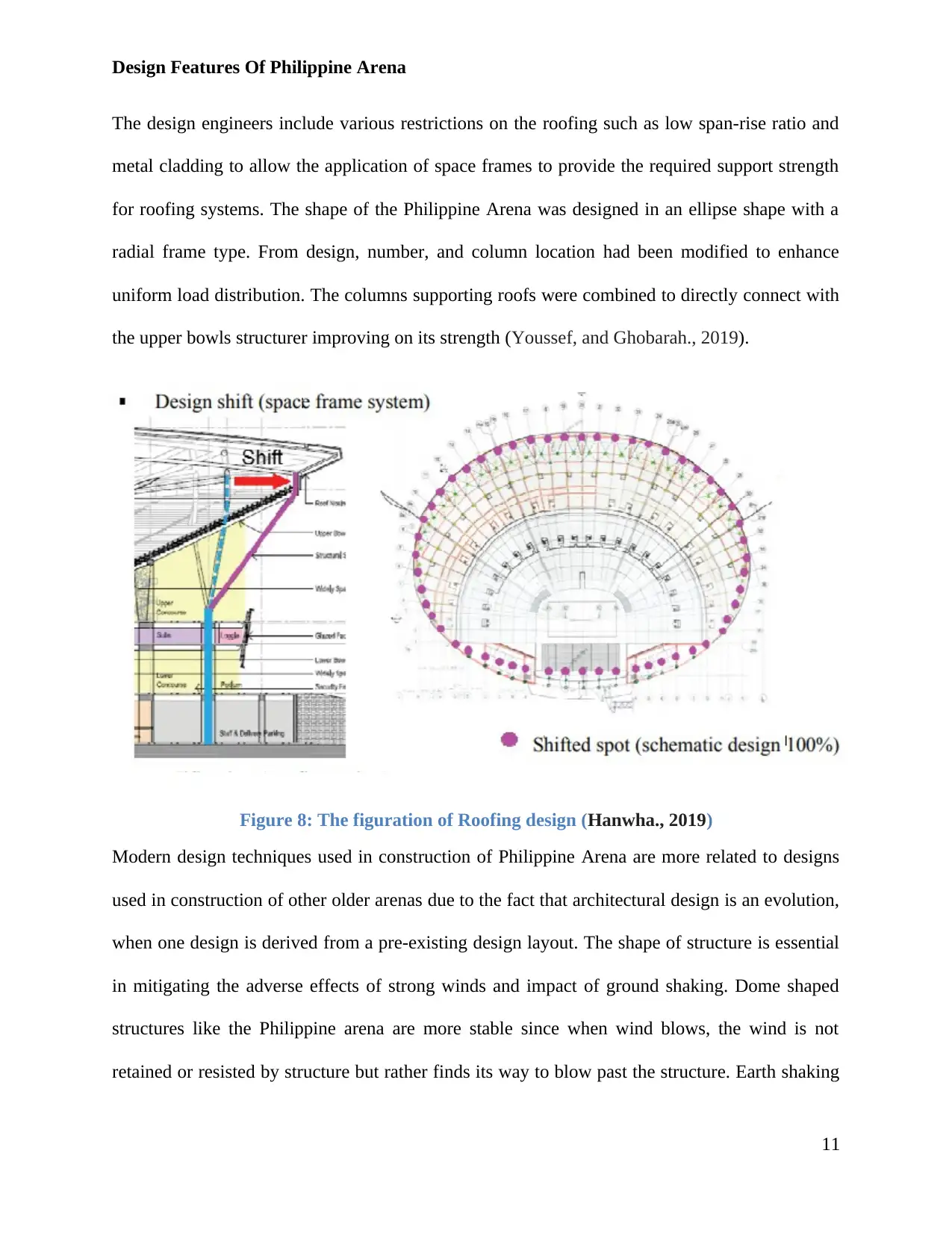
Design Features Of Philippine Arena
The design engineers include various restrictions on the roofing such as low span-rise ratio and
metal cladding to allow the application of space frames to provide the required support strength
for roofing systems. The shape of the Philippine Arena was designed in an ellipse shape with a
radial frame type. From design, number, and column location had been modified to enhance
uniform load distribution. The columns supporting roofs were combined to directly connect with
the upper bowls structurer improving on its strength (Youssef, and Ghobarah., 2019).
Figure 8: The figuration of Roofing design (Hanwha., 2019)
Modern design techniques used in construction of Philippine Arena are more related to designs
used in construction of other older arenas due to the fact that architectural design is an evolution,
when one design is derived from a pre-existing design layout. The shape of structure is essential
in mitigating the adverse effects of strong winds and impact of ground shaking. Dome shaped
structures like the Philippine arena are more stable since when wind blows, the wind is not
retained or resisted by structure but rather finds its way to blow past the structure. Earth shaking
11
The design engineers include various restrictions on the roofing such as low span-rise ratio and
metal cladding to allow the application of space frames to provide the required support strength
for roofing systems. The shape of the Philippine Arena was designed in an ellipse shape with a
radial frame type. From design, number, and column location had been modified to enhance
uniform load distribution. The columns supporting roofs were combined to directly connect with
the upper bowls structurer improving on its strength (Youssef, and Ghobarah., 2019).
Figure 8: The figuration of Roofing design (Hanwha., 2019)
Modern design techniques used in construction of Philippine Arena are more related to designs
used in construction of other older arenas due to the fact that architectural design is an evolution,
when one design is derived from a pre-existing design layout. The shape of structure is essential
in mitigating the adverse effects of strong winds and impact of ground shaking. Dome shaped
structures like the Philippine arena are more stable since when wind blows, the wind is not
retained or resisted by structure but rather finds its way to blow past the structure. Earth shaking
11
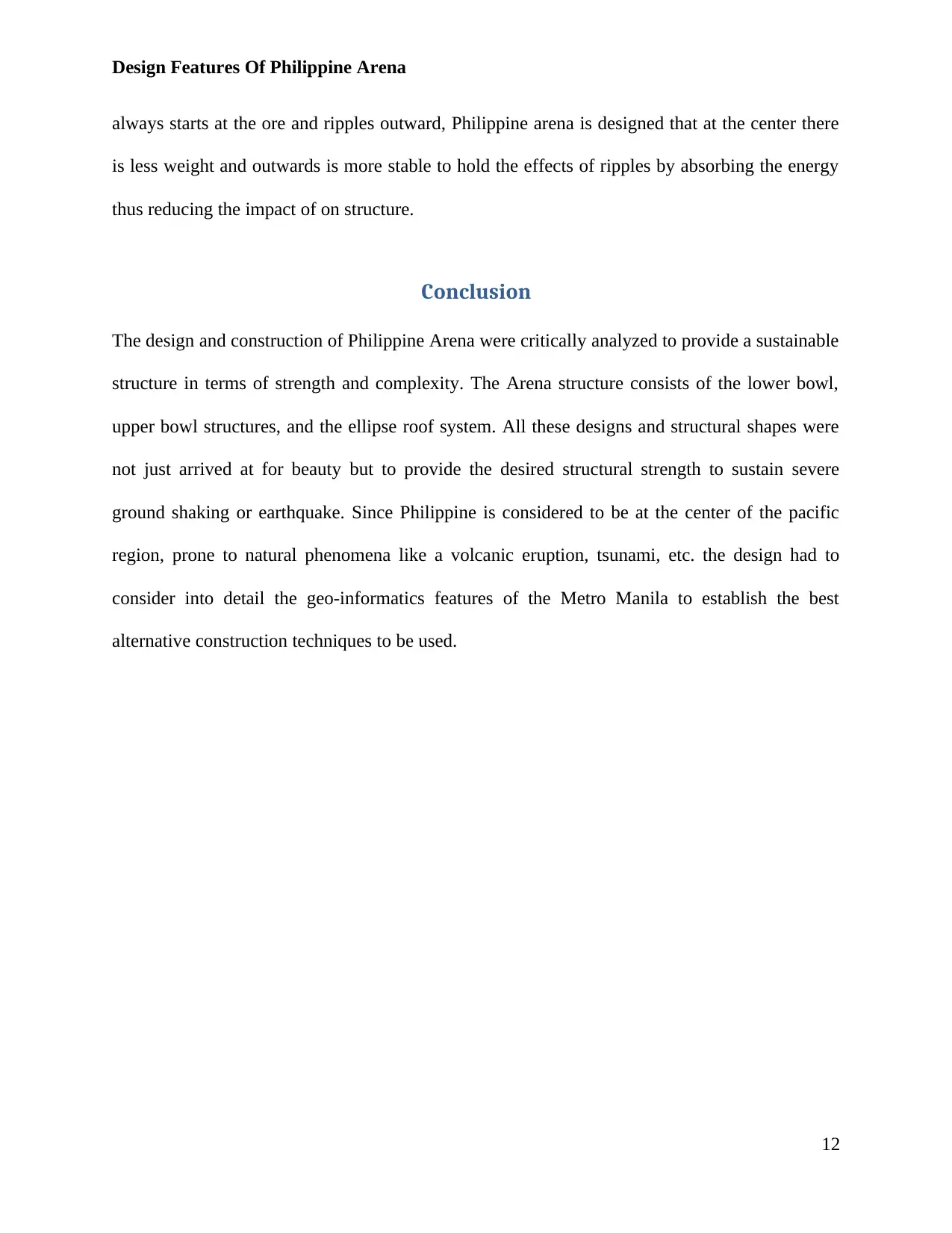
Design Features Of Philippine Arena
always starts at the ore and ripples outward, Philippine arena is designed that at the center there
is less weight and outwards is more stable to hold the effects of ripples by absorbing the energy
thus reducing the impact of on structure.
Conclusion
The design and construction of Philippine Arena were critically analyzed to provide a sustainable
structure in terms of strength and complexity. The Arena structure consists of the lower bowl,
upper bowl structures, and the ellipse roof system. All these designs and structural shapes were
not just arrived at for beauty but to provide the desired structural strength to sustain severe
ground shaking or earthquake. Since Philippine is considered to be at the center of the pacific
region, prone to natural phenomena like a volcanic eruption, tsunami, etc. the design had to
consider into detail the geo-informatics features of the Metro Manila to establish the best
alternative construction techniques to be used.
12
always starts at the ore and ripples outward, Philippine arena is designed that at the center there
is less weight and outwards is more stable to hold the effects of ripples by absorbing the energy
thus reducing the impact of on structure.
Conclusion
The design and construction of Philippine Arena were critically analyzed to provide a sustainable
structure in terms of strength and complexity. The Arena structure consists of the lower bowl,
upper bowl structures, and the ellipse roof system. All these designs and structural shapes were
not just arrived at for beauty but to provide the desired structural strength to sustain severe
ground shaking or earthquake. Since Philippine is considered to be at the center of the pacific
region, prone to natural phenomena like a volcanic eruption, tsunami, etc. the design had to
consider into detail the geo-informatics features of the Metro Manila to establish the best
alternative construction techniques to be used.
12
⊘ This is a preview!⊘
Do you want full access?
Subscribe today to unlock all pages.

Trusted by 1+ million students worldwide
1 out of 14
Your All-in-One AI-Powered Toolkit for Academic Success.
+13062052269
info@desklib.com
Available 24*7 on WhatsApp / Email
![[object Object]](/_next/static/media/star-bottom.7253800d.svg)
Unlock your academic potential
Copyright © 2020–2025 A2Z Services. All Rights Reserved. Developed and managed by ZUCOL.